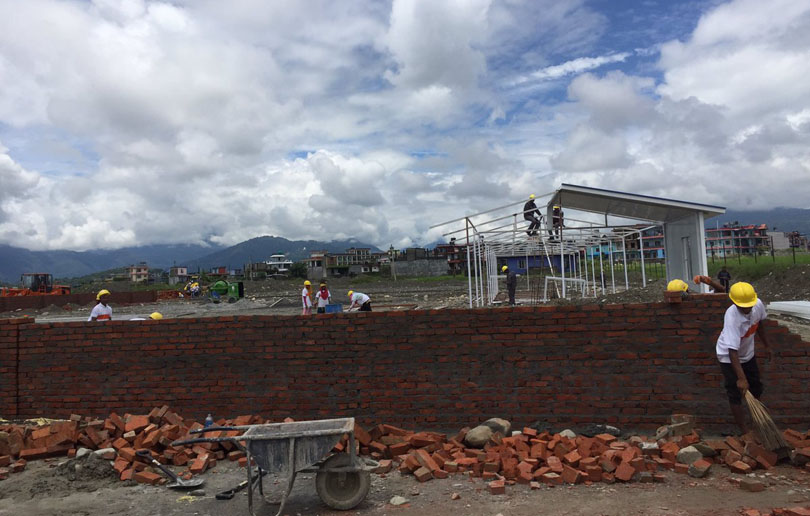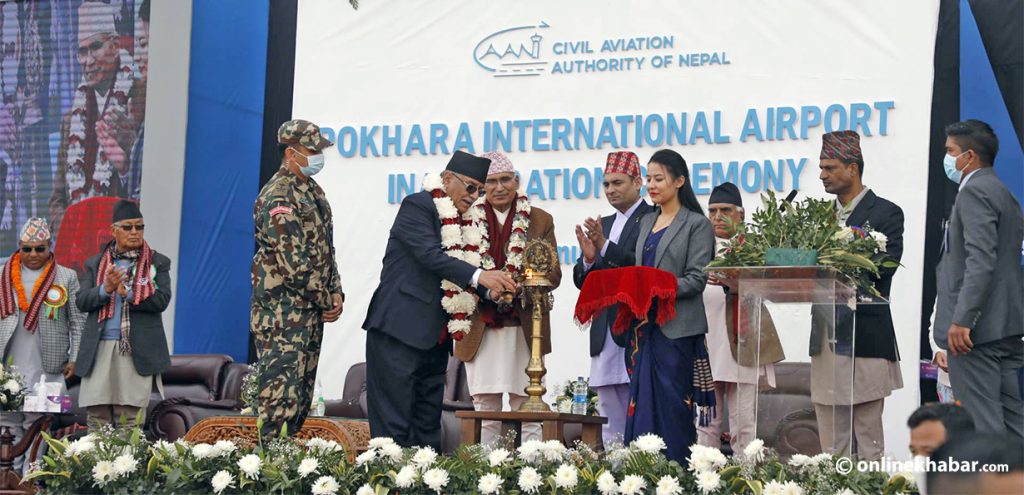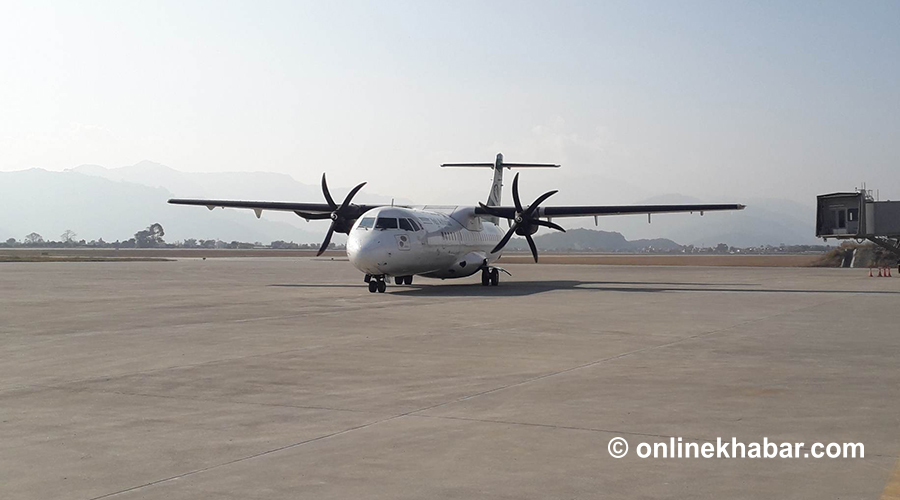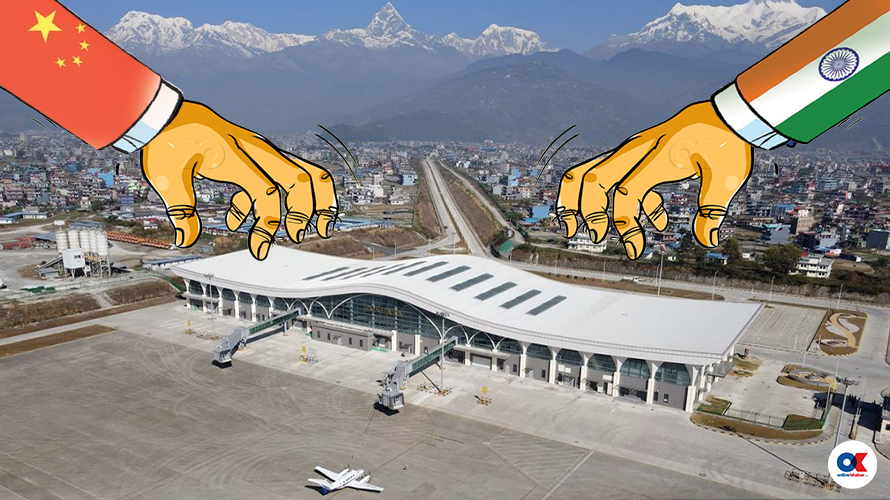
The Commission for Investigation of Abuse of Authority (CIAA) team requested documents related to the construction of Pokhara Regional International Airport from the Civil Aviation Authority of Nepal (CAAN) in November 2023. Despite repeated requests, the CAAN’s director general, Pradeep Adhikari, hesitated to submit the requested documents. Frustrated, the CIAA even called him to its office asking for an explanation.
In the presence of the DIG, also the head of the police division; the head of the CIAA, Prem Kumar Rai, asked Adhikari to provide the required documents.
“If you do not cooperate, we will use other means to get the documents,” Rai told Adhikari.
During the discussion, a source indicated that when Rai suggested an alternative method to obtain the documents, Adhikari gestured towards the head of the police division. It was at that moment that the CAAN provided the documents and details of the Pokhara Airport construction process.
There has been speculation of corruption while building the Pokhara Airport. Some even argue that this is the biggest corruption case ever in Nepal.
To understand whether the speculation was right, Onlinekhabar spoke to an auditor from the Office of the Auditor General, an engineer who worked on the Pokhara Airport project, and a technician from the CIAA who remained anonymous. All three sources agree that the level of irregularities observed during the construction of the airport might be the most significant thus far.
Cost saving and its impact on Pokhara Airport

As per the agreement between CAAN and China CAMC Engineering Company Limited, the airport was required to be filled with soil and gravel sourced from a distance of five kilometres. This would elevate the airport’s height slightly compared to its current level.
However, the Chinese company used soil and gravel from the immediate vicinity for construction purposes, rather than transporting it from a distance of five kilometres as stipulated. Interestingly, the Chinese company allocated USD 80 million for transportation costs but did not stick to the specified requirement, thereby saving a significant amount.
As a result of this, the runway of Pokhara Airport has been adversely affected. As the airport’s height is lower than planned, Nepal will bear the price of this oversight over the long run.
The report prepared by the Auditor General’s office last year indicated that aircraft are required to pass at a height of 40 kilometres from the east of Chhine Danda, rather than the originally planned 30 kilometres, due to the low elevation of the runway.
According to sources from the CIAA involved in the investigation of the Pokhara Airport, this disparity has led to increased costs and necessitates the removal of the water tank built in that area. Furthermore, there is a situation where aircraft must take off with a reduced load compared to their actual capacity.
This deviation from the agreed-upon plan has resulted in the Chinese company making millions of dollars while Nepal has incurred long-term losses. The General Accountant noted in their report, “Given that the raw materials (stones, soil, and gravel) which builders are obligated to source from a distance of 5 kilometres involve royalty payments, the implications for external procurement and transportation costs for businesses should be thoroughly analysed.”
Budget and discretionary payments
The CAAN gave the contract to a Chinese company on the EPC model. According to a CIAA engineer, under this model, once the contract is awarded, the authority is responsible for providing all information regarding engineering design, material procurement, and construction to the relevant construction company. However, any additional services provided by the construction company cannot be reimbursed.
However, an additional payment of Rs 2 billion has been made based on the bill of quantity (BoQ) sent by the Chinese company to CAAN. According to the details received by Onlinekhabar, the money was released even though the consultants had pointed out to CAAN that it would be wrong to make such a payment.
The Office of the Auditor General has also followed the matter of exemptions. The responsibility for payment for beautification, including taxes and fees, falls on the agency that secured the contract. However, the auditor general’s report mentions that the Civil Rights Authority of Pokhara managed to secure an exemption of Rs 2.22 billion by listing the project on the master list.
Apart from this, a question has also been raised about the selection of Nepali consultants. From the budget perspective, a Korean consultancy company was appointed for the construction of Bhairahawa Airport, which is half the size of Pokhara Airport. However, in Pokhara, a Nepali consultancy company called ERMC was appointed without international competition, and the payment was made based on its decision.
According to a technician at CAAN, the standard procedure involves submitting documents, including reports prepared by the contractor company, to the consultancy for approval initially. This approval is granted only after a thorough study and on-site inspection of the report. Subsequently, the approved documents are forwarded to CAAN. It was decided that CAAN would also adopt this process to liaise with the contractor, thereby reducing the consultant’s role to a secondary one.
“The consultant’s role was diminished as CAAN continued to deal directly with the contractor, and the contractor directly with CAAN. This type of arrangement is not common in such large construction contracts,” said an engineer working at CAAN on the condition of anonymity.
The burden of the foreign exchange rate on Nepal

According to the details mentioned in the agreement made in 2016, the exchange rate of the US dollar was Rs 82. Payments and transactions had to be made by fixing the exchange rate on the day of the contract. However, later the payment was made according to the exchange rate of the day of the transaction.
As of today, certain airport works remain unfinished, and payments are being made based on the current exchange rate, which stands at Rs 132 per US dollar. A source from CAAN mentioned that due to the exchange rate fluctuations at the time of payment following bill submission, there has been a significant loss incurred during the transaction.
According to the contract agreement for the construction of the airport, the contractor (Chinese company) was bound to appoint a consultant. However, it failed to fulfil this responsibility but still claimed expenses for it. CAAN itself ended up appointing a consultant. CIAA sources revealed that when the exchange rate fluctuated, the payment amount increased by approximately 65 per cent.
It is not impossible to alter the rate of certain tasks after the contract has been agreed upon. However, the rationale and justification for such adjustments must be thoroughly confirmed. It must be acknowledged that if the lowest bidder wins the contract during the competition, subsequently increasing the rate may not be unfair to the other party.
“If there is a question about new issues and rates, the consultant and the representative of the CAAN should sit down and resolve it but it has been done abruptly,” said a CAAN source.
Question on quality

According to sources within the CIAA, foundational documents and data analyses were neglected during the construction of the airport. A soil test report, a prerequisite for the construction of the structure, was missing. Additionally, certain building and structure designs were not provided by the contractor company to the consultant as required.
CIAA spokesperson Nara Hari Ghimire said that the investigation of the complaint about the construction of Pokhara Airport is ongoing.
“We don’t know the in-depth details of the investigation but we can assure that the investigation is ongoing,” says Ghimire.
According to a technician from CAAN, the drainage system was constructed without considering the rainfall rate in Pokhara. Additionally, he mentioned that the foundation required for the terminal building was not excavated. Besides these significant issues, he highlighted various other irregularities related to quality testing that have not been addressed and should be separately accounted for.
The CIAA is conducting an investigation into Pradeep Adhikari, the director general of the Civil Aviation Authority of Nepal (CAAN), based on allegations of illegal wealth acquisition. Despite repeated attempts by Onlinekhabar to contact CAAN officials through various channels, they have declined to respond or provide comment.
The unsustainable airport

Pokhara Aiport has seen five international flights so far and all of them were chartered flights. Due to the presence of Chine Danda near the airport, wide-body aircraft are currently unable to take off or land. A retired pilot from the Nepal Airlines Corporation has indicated that the height of the runway and the hill are mismatched, necessitating wide-body aircraft to reduce their maximum take-off weight to operate safely.
On March 21, 2016, a loan agreement was signed between the Government of Nepal and China. The agreement stipulated a total loan amount of Chinese Yuan 1.37 billion, out of which Chinese Yuan 355.9 million constituted an interest-free loan. The Civil Aviation Authority of Nepal (CAAN) is responsible for repaying the remaining amount, including interest, in instalments by the year 2036.
According to the exchange rate at the time of the agreement, the total loan amount of Chinese Yuan 1.37 billion would equate to approximately Rs 22.61 billion. Out of this sum, Rs 5.83 billion represents interest that does not need to be repaid. Nepal is obligated to pay Rs 800.4 million annually to the Chinese Exim Bank solely for interest. Within two and a half months of the agreement, Nepal received a loan with interest to be repaid within 20 years.
The construction of Pokhara Airport, based on political consensus, indicates a shared agreement within the country regarding corruption in major projects. Economist Swarnim Wagle says, “Increasing the cost to a large extent and showing some reduction in the progress of the Pokhara airport construction project is intentional. This cannot be achieved without political help.”
Amid the chaos of geopolitics

The technicians who worked at the Pokhara Airport said that there had been a political setting for corruption even before the construction started. After its construction, this airport, which is said to be a project of national pride, has become a victim of geopolitical interests.
After the second People’s Movement, the government requested the Asian Development Bank (ADB) to conduct a feasibility study for building an international airport in Pokhara. According to an employee familiar with the developments at that time, the government intended to secure a loan from ADB and assume responsibility for the feasibility study to construct a second international airport in Pokhara following Kathmandu.
The conclusion of the feasibility study team contradicted the government’s plan regarding the construction of an international airport in Pokhara. The study team’s report highlighted that operating an airport in Pokhara would pose significant financial and technical challenges.
The complications of the international airport operation in Pokhara were mentioned point by point as per Ishwari Prasad Paudyal who represented the then Ministry of Physical Planning and Infrastructure in the meeting (called to present the conclusion of the feasibility of Pokhara Airport) under the leadership of the Ministry of Tourism. The main thing among them was that it was not feasible financially to establish an international airport in Pokhara.
“The report mentioned the airport did not make sense financially. With no agreement signed with India regarding the air routes, the airport did not make sense,” says Paudyal. “Secondly, everyone wants to come to Kathmandu and no foreign airline company will agree to go to Pokhara.”
The feasibility study report involving representatives of the ADB office and CAAN also pointed out the geographical location as a challenge for the operation of an international airport in Pokhara.
“It would be technically difficult to land an aircraft due to the hills around Pokhara,” said Paudyal, “The government was asking for a soft loan from ADB but it disagreed showing that it was not feasible, which is written in the meeting’s minutes.”
ADB concluded that if the loan was invested mainly in Pokhara Airport, it would not be recovered. With that, it withdrew from the construction of Pokhara Airport.
According to security sources, regardless of ADB’s findings, Pokhara is a business and tourist centre of choice for the Chinese as it is a strategically important place connecting Tibet to China through the Korla border. The tourist city Pokhara, where the Tibetan refugee centre is located, also comes under the interest of Western countries. Hence, China intended to build an international airport in Pokhara to increase its influence.
For that, the Chinese initially began fostering a favourable environment for airport construction by deepening relations with parties such as the UML and later the Nepali Congress, which were ideologically aligned with them. All major political parties in Nepal agreed to construct an international airport in Pokhara, hoping that a significant development project would garner publicity and yield financial benefits.
Nepal renewed the air agreement with India in 2009 as an attempt to find a solution to the ADB’s conclusion influenced by geopolitical issues also with technical issues. According to the agreement, it was agreed that apart from Kathmandu, Indian airlines will also be allowed to land at airports outside the capital.
In the agreement, it was agreed that Indian airlines would be allowed to land at Pokhara, Nepalgunj, Biratnagar, Janakpur, Bhairahawa and Dhangadhi. Similarly, India agreed to provide facilities for Nepali airlines to fly to airports including New Delhi, Bangalore, Chennai, Mumbai, Kolkata and Hyderabad.
Encouraged by the air service agreement signed by the then Minister of Tourism Sarat Singh Bhandari and his Indian counterpart SM Krishna, Nepal proceeded with the process of airport construction agreement to strengthen Chinese interest.
In 2014, the Civil Aviation Authority of Nepal (CAAN) reached an agreement with China CAMC Engineering for the construction of the airport, despite recommendations from experts of the Asian Development Bank advising against it.
According to the agreement, in 2016, the government of Nepal and the China Exim Bank agreed to provide a loan of USD 216 million for the construction of the airport, and the Chinese company CAMC would undertake the construction of the Pokhara airport as a ‘turnkey project‘.
According to the agreement between the two countries, the design, procurement and construction of the Pokhara Airport with a 45-metre wide and 2,500-metre long runway had to be completed and handed over to Nepal. Since the airport was built with Chinese loans, it was conditioned that only Chinese companies could compete.
According to the conditions, China CAMC Engineering Company was selected out of the nine that applied, while IPPR, which was developed as its sister organisation, was selected as the main consultant company. ERMC was appointed as a consultant on behalf of CAAN.
According to an engineer who worked there, both the consulting companies were appointed only to approve the work of China CAMC Engineering Company, which got the contract for the construction of the airport.
“Among these two companies, the Chinese company was not qualified to work as an independent consultant, while the Nepali company was not capable of working as a consultant in such a large project,” said the engineer.
After the agreement, in April 2016, Prime Minister Pushpa Kamal Dahal laid the foundation stone of the airport to complete the construction work in July 2021. Due to the Covid pandemic, the construction work was affected. The project had to wait until January 2023 to be inaugurated.
With the inauguration of the Pokhara Airport, there was widespread anticipation that the air traffic pressure on Kathmandu would reduce and Pokhara would establish connections with international cities. Buddha Air, a private sector airline company in Nepal, had devised plans to commence flights from Pokhara to Varanasi and gradually expand services to other cities in India. Corresponding proposals were submitted to India in this regard. However, India did not approve the air plan to link Indian cities with the airport constructed with Chinese investment.
As indicated in the ADB report, commercial international flights have been unable to land in Pokhara due to India’s refusal to permit the use of the air route. Even if India were to allow the use of the air route, there remains a technical hurdle regarding the ability to land and operate large aircraft at full capacity. To facilitate the operation of the airport, which is situated three kilometres east of the old domestic airport, the CAAN itself has undertaken the task of cutting an 817-metre-high hill, thereby enabling large aircraft to land.
According to sources, alongside negotiations regarding the air service agreement, India sought to gain management control over Tribhuvan International Airport. However, due to Nepal’s security concerns and reluctance to entrust airport management to an Indian company, India withdrew its commitment to granting Nepal an air route.
Holding on to the BRI statement

During the inauguration of the airport on January 1, 2023, Chen Song, the Chinese ambassador to Nepal, expressed through social media that Pokhara Airport is an integral part of the Belt and Road Initiative, an ambitious development concept of Chinese President Xi Jinping.
Nepal promptly denied Ambassador Song’s statement. However, Song’s statement contradicts the genuine intent of assisting in the operation of the airport and instead has been utilised as propaganda material by India and Western countries, insinuating that China built Pokhara Airport for strategic purposes.
Taking a policy of not even buying electricity produced by Chinese companies in Nepal, India has not allowed any aircraft to travel from the Chinese-invested airport to the Indian airport. After China explained it as a BRI project from the public forum, pretending to have achieved great success by building an airport with Chinese investment in Pokhara, the southern neighbour has become more irritated towards Nepal in aviation matters.
Analysts say that this has caused more complications in the operation of Pokhara Airport.
“We are falling into the trap of geopolitics. China will be dissatisfied if all three airports are given to the Indian group, India occupies a large part of the market given to China’, analyst Chandra Dev Bhatt says, “We have not been able to balance the other stakeholders including the two neighbours.”
However, the Chinese side does not want to back down from the statement that the airport is under the BRI project. On June 21, 2023, when a Sichuan Airlines aircraft landed, the Chinese ambassador, who came to Pokhara, repeated his old stance during a short interview.
“Even if it is difficult for Nepal to accept that the Pokhara Airport was built under the BRI project, for China this is primarily a BRI connectivity project,” he said.
The Chinese ambassador’s statement has placed Nepal in an even more delicate situation. Currently, India has not granted flight permissions to Pokhara Airport, constructed with Chinese investment, and Gautam Buddha Airport in Bhairahawa, built by a Chinese company, as per the pre-construction agreements. It has been over a year since commercial flights commenced.
Currently, India has not granted flight permission to Pokhara Airport, constructed with Chinese investment, and Gautam Buddha Airport in Bhairahawa, built by a Chinese company, as per the pre-construction agreement. It has been over a year since commercial flights have commenced.
It has already been five months since the Prime Minister visited China and despite the commitment in the joint statement, no Chinese airlines have operated commercial flights to Pokhara. Neither has any Nepali airline company started international air service from Pokhara. Since the Pokhara Airport, which is stuck in the geopolitics of China and India, is not operational, the Nepali airline companies that are waiting for the expansion of air services are also stuck.
“From the day the airport was inaugurated, we had planned to start Varanasi-Pokhara flights twice a week and increase the flight frequency to Dehradun and Delhi as well,” Buddha Air spokesperson Dipendra Kumar Karn said. “According to that plan, we had sent a proposal to the Ministry of Foreign Affairs and the Civil Aviation Authority of Nepal. However, we have not received permission yet.”
India’s eye on Nepali airports
Similar to Pokhara Airport, which was built with Chinese investment, the Bhairahawa Airport near the Nepal-India border, funded by the ADB, has not achieved the expected success. Prime Minister Pushpa Kamal Dahal has publicly expressed plans for operating three international airports under the public-private partnership concept, along with the construction of the controversial Nijgadh Airport.
According to authoritative sources, there is regular dialogue between the Director-General of the Civil Aviation Authority, Pradeep Adhikari, and Prime Minister Dahal as part of the same plan. However, Adhikari, who leads the project to advance the construction process of Pokhara Airport, is currently under investigation for financial irregularities during the construction of both the Bhairahawa Airport and CAAN headquarters.
Adhikari, himself under investigation for allegations of amassing wealth, claims that the Indian company Adani Group, led by Gautam Adani, is seeking to operate Kathmandu, Pokhara, and Bhairahawa airports under a public-private partnership, as well as to construct the Nijgadh airport.
According to Jagannath Niraula, spokesperson of the authority, a proposal to advance the operation of the constructed international airport and the construction of the Nijgadh Airport through public-private partnership has already been prepared by CAAN and sent to the Ministry of Culture, Tourism, and Civil Aviation. Subsequently, the cabinet has formed a study committee to determine the course of action regarding public-private partnerships and legal arrangements, Niraula said.
A committee member expressed confidence that the committee, mandated to submit a report within 45 days, will recommend the operation and construction of the airport to the Indian company.
“Considering the current situation, it seems unlikely for any company other than Indian companies to operate the airport, as India does not grant permission to use its airspace,” the member added.


























